#Desert of Namibia
Explore tagged Tumblr posts
Text

Yoko Yamanaka
- Desert of Namibia
2024
20 notes
·
View notes
Text
Japanese Films at the Busan International Film Festival 2024 (02nd-11th October)
The full programme for the 2024 edition of the Busan International Film Festival is out and there are a lot of Japanese films, some of which are mainstream titles that have hit multiplexes, some of which are familiar from other fall festivals, some of which are screening ahead of release in their home nation and two of which are an international co-production between Japan and France, one of…
#A Garden in Winter#Aimitagai#Ainu Puri#Beyond Goodbye#Busan International Film Festival#Cloud#Desert of Namibia#Ghost Cat Anzu#HAPPYEND#Kaneko’s Commissary#Magic Candies#Serpent’s Path (2024) / Le chemin du serpent#Spirit World#Super Happy Forever#Swimming in a Sand Pool#The Colours Within#The Height of the Coconut Trees#The Moon#The Solitary Gourmet Movie#Traveling Alone
0 notes
Text










"Вызывающе-оранжевенькая серия" от фотографа Moro. Россия (Москва).
"Provocatively orange series" by photographer Moro. Russia (Moscow).
Расположенный в Намибии Национальный парк Намиб-Науклуфт занимает часть пустыни Намиб и горной цепи Науклуфт. Пустыня Намиб считается самой старой на планете. Площадь парка составляет примерно 50 000 квадратных километров, и поэтому он является самым большим в Африке и четвертым по величине в мире. Создание Науклуфта началось в 1907 году. Самыми посещаемыми и наиболее известными частями парка являются Соссусфлей и Дедвлей.
Плато Соссусфлей— царство песчаных дюн, из которых около 90 % состоят из кварцевого песка. На некоторых из них заметны места с песком более тёмных красновато-чёрных оттенков. Пески появились здесь благодаря восточным ветрам, которые принесли их сюда из центральной части восточной Намибии. Некоторые песчинки покрыты оксидом железа, который придаёт им характерный красный цвет. В некоторых частях Соссусфлей встречаются двухцветные красно-жёлтые дюны.
Дедвлей (Deadvlei) — это высохшее, после окружения дюнами, болото в русле этой же реки. На высохшей несколько сот лет назад глине серого цвета, остались деревья (верблюжья акация). В сухом жарком климате, древесина акаций окаменела. Деревья сохранили свой первородный вид, только без листьев.
Впечатляют своей красотой горы заповедника, выступающие прямо посреди пустыни. Их склоны довольно скалистые и укрыты редкой растительностью, оврагами и зелеными долинами. Эта область привлекает мало посетителей, так как является труднопроходимой. Она подходит для организованных серьезных походов.
Located in Namibia, the Namib-Naukluft National Park occupies part of the Namib Desert and the Naukluft Mountain Range. The Namib Desert is considered the oldest desert on the planet. The park covers an area of approximately 50,000 square kilometers, making it the largest park in Africa and the fourth largest in the world. The creation of the Naukluft began in 1907. The most visited and best known parts of the park are Sossusvlei and Deadvlei.
The Sossusvlei Plateau is a kingdom of sand dunes, about 90% of which are made up of quartz sand. Some of them have areas with darker reddish-black sand. The sands were formed here by easterly winds that brought them here from the central part of eastern Namibia. Some grains of sand are coated with iron oxide, which gives them a characteristic red color. In some parts of Sossusvlei, two-tone red and yellow dunes are found.
Deadvlei is a dried-up swamp in the same river bed after being surrounded by dunes. On the gray clay that dried up several hundred years ago, trees (camel acacia) remained. In the dry, hot climate, the acacia wood petrified. The trees retained their original appearance, only without leaves.
The mountains of the reserve, jutting out right in the middle of the desert, are impressive in their beauty. Their slopes are quite rocky and covered with sparse vegetation, ravines and green valleys. This area attracts few visitors, as it is difficult to pass. It is suitable for organized serious hikes.
Источник: /35photo.pro/photo_523453/#author/523453, //yii2.rutraveller.ru/place/11744, /35photo.pro/moro/, /ru.wikipedia.org/wiki/Намиб-Науклуфт, //awd.is/sossusvlei-dune-dedvlei-trees.
#photographer#Moro#Namibia#nature#landscape photography#Namib-Naukluft#landscape#desert#Sossusvlei#Deadvlei#dunes#sand#dead trees#sky#clouds#фотограф#Намибия#пейзаж#природа#Намиб-Науклуфт#пустыня#Соссусфлей#Дедвлей#дюны#мертвые деревья#песок#небо#тучи
173 notes
·
View notes
Text
"Namibia is the driest country in Sub-Saharan Africa, and home to two of the world’s most ancient deserts, the Kalahari and the Namib. The capital, Windhoek, is sandwiched between them, 400 miles away from the nearest perennial river and more than 300 miles away from the coast. Water is in short supply.
It’s hard to imagine life thriving in Windhoek, yet 477,000 people call it home, and 99 per cent of them have access to drinking water thanks to technology pioneered 55 years ago on the outskirts of the city. Now, some of the world’s biggest cities are embracing this technology as they adapt to the harshest impacts of climate change. But Namibia leads the way.
How did this come about? In the 1950s, Windhoek’s natural resources struggled to cope with a rapidly growing population, and severe water shortages gripped the city. But disaster forced innovation, and in 1968 the Goreangab Water Reclamation Plant in Windhoek became the first place in the world to produce drinking water directly from sewage, a process known as direct potable reuse (DPR).
That may sound revolting, but it’s completely safe. Dr Lucas van Vuuren, who was among those who pioneered Windhoek’s reclamation system, once said that “water should not be judged by its history, but by its quality”. And DPR ensures quality.
This is done using a continuous multi-barrier treatment devised in Windhoek during eight years of pilot studies in the 1960s. This process – which has been upgraded four times since 1968 – eliminates pollutants and safeguards against pathogens by harnessing bacteria to digest the human waste and remove it from the water. This partly mimics what happens when water is recycled in nature, but Windhoek does it all in under 24 hours...
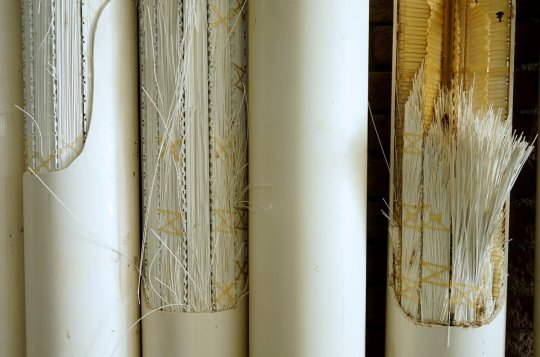
Pictured: These ultrafiltration membranes help to remove bacteria, viruses and pathogens. Image: Margaret Courtney-Clarke
“We know that we have antibiotics in the water, preservatives from cosmetics, anti-corrosion prevention chemicals from the dishwasher,” Honer explains. “We find them and we remove them.”
Honer adds that online instruments monitor the water continuously, and staff ensure that only drinking water that meets World Health Organisation (WHO) guidelines is sent to homes. If any inconsistencies are detected, the plant goes into recycle mode and distribution is halted until correct values are restored.
“The most important rule is, and was, and always will be ‘safety first’,” says Honer. The facility has never been linked to an outbreak of waterborne disease, and now produces up to 5.5m gallons of drinking water every day – up to 35 per cent of the city’s consumption.
Namibians couldn’t survive without it, and as water shortages grip the planet, Windhoek’s insights and experience are more important than ever.
Interest from superpowers across the globe
In recent years, delegations from the US, France, Germany, India, Australia, Singapore, and the United Arab Emirates have visited Windhoek seeking solutions to water shortages in their own countries.
Megadrought conditions have gripped the US since 2001, and the Colorado River – which provides 40 million people with drinking water – has been running at just 50 per cent of its traditional flow. As a result, several states including Texas, California, Arizona and Colorado are beginning to embrace DPR.
Troy Walker is a water reuse practice leader at Hazen and Sawyer, an environmental engineering firm helping Arizona to develop its DPR regulations. He visited Windhoek last year. “It was about being able to see the success of their system, and then looking at some of the technical details and how that might look in a US facility or an Australian facility,” he said. “[Windhoek] has helped drive a lot of discussion in industry. [Innovation] doesn’t all have to come out of California or Texas.”

Pictured: The internal pipes and workings of Namibia's DPR plant. As water becomes scarcer in some parts, countries are looking to DPR for solutions. Image: Margaret Courtney-Clarke
Namibia has also helped overcome the biggest obstacle to DPR – public acceptance. Disgust is a powerful emotion, and sensationalist ‘toilet to tap’ headlines have dismantled support for water reuse projects in the past. Unfortunately, DPR’s biggest strength is also its biggest weakness, as the speed at which water can re-enter the system makes it especially vulnerable to prejudice, causing regulators to hesitate. “Technology has never been the reason why these projects don’t get built – it’s always public or political opposition,” says Patsy Tennyson, vice president of Katz and Associates, an American firm that specialises in public outreach and communications.
That’s why just a handful of facilities worldwide are currently doing DPR, with Windhoek standing alongside smaller schemes in the Philippines, South Africa and a hybrid facility in Big Spring, Texas. But that’s all changing. Drought and increased water scarcity worldwide are forcing us to change the way we think about water.
Now, the US is ready to take the plunge, and in 2025, El Paso Water will begin operating the first ‘direct to distribution’ DPR facility in North America, turning up to 10m gallons of wasterwater per day into purified drinking water – twice as much as Windhoek. San Diego, Los Angeles, California, as well as Phoenix, Arizona are also exploring the technology."
Of course, DPR is not a silver bullet in the fight against climate change. It cannot create water out of thin air, and it will not facilitate endless growth. But it does help cities become more climate resilient by reducing their reliance on natural sources, such as the Colorado River.
As other nations follow in Namibia’s footsteps, Windhoek may no longer take the lead after almost six decades in front.
“But Windhoek was the first,” Honer reminds me. “No one can take that away.”"
-via Positive.News, August 30, 2023
#namibia#africa#desert#water shortage#water conservation#dpr#potable water#water recycling#clean water#drought#united states#colorado river#science and technology#sanitation#good news#hope
2K notes
·
View notes
Text
Namib Sand Geckos: these nocturnal geckos have biofluorescent markings that emit a bright, neon-green glow when exposed to the moonlight
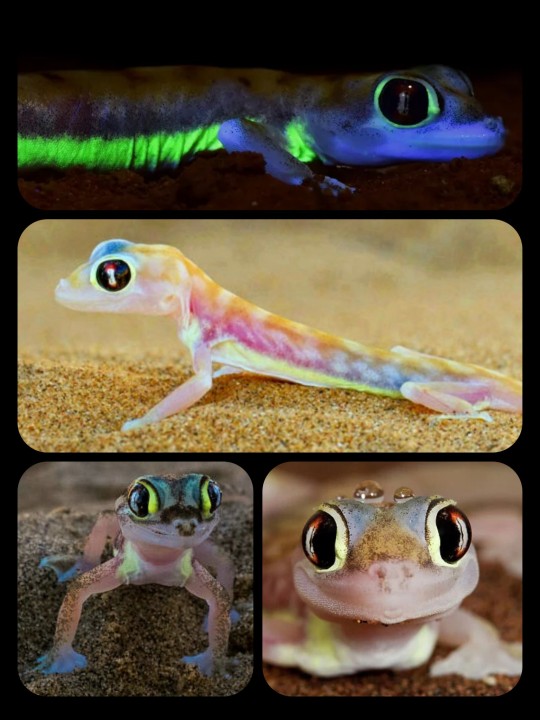
This species (Pachydactylus rangei) is found only in the Namib Desert, which stretches across Namibia, Angola, and South Africa; the geckos typically inhabit the arid, coastal region known as the Skeleton Coast.
In order to escape from the blistering heat of the desert, they use their webbed feet to burrow down into the sand during the day, and then emerge only at night, when the temperature has finally dropped. The webbing on their feet also enables them to run more easily across the dunes.

Namib sand geckos are covered in translucent scales, but they also have a strangely colorful appearance, as the colors/shades of their circulatory system, spinal column, internal organs, and optical membranes remain partially visible through the skin, producing various shades of pink, dark blue, purple, magenta, orange, and yellow.
They also have several distinctive markings running along their lower flank and encircling their eyes; these markings are known to fluoresce when exposed to UV light (including moonlight), emitting a bright, neon-green glow.

Some researchers have theorized that the biofluorescent markings may act as a signal to other geckos, allowing them to locate one another in the vast, desolate expanse of the desert, as this paper explains:
The fluorescent areas of P. rangei are concentrated around the eyes and along the lower flanks. This positioning is practically invisible to predators with a higher perspective (e.g. birds and jackals), but highly conspicuous from a gecko’s perspective. As P. rangei is sociable but generally solitary, and occurs at low population densities, such a signal might serve to locate conspecifics over greater distances ...
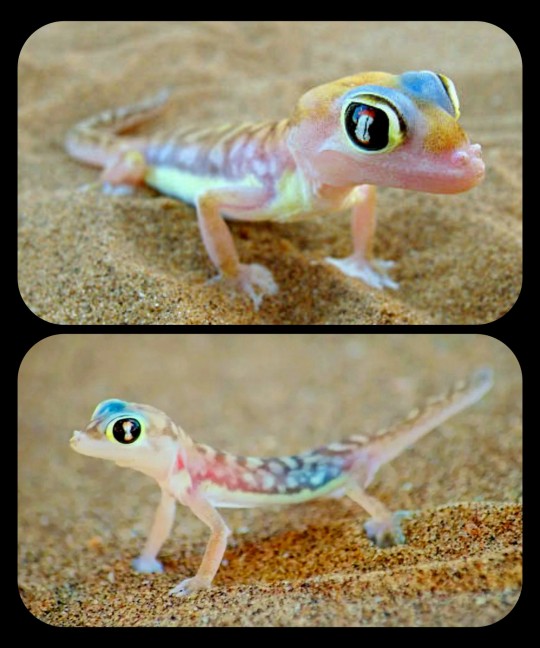
Encounters in P. rangei might serve purposes beyond mating opportunities: as the Namib desert has extremely low precipitation, fog is a key water source for its flora and fauna. Fog condenses on the bodies of the geckos, and they lick it from their faces. In husbandry, we have observed individuals licking water from conspecifics, taking advantage of a much greater available surface area.
Additionally, after short periods of isolation, the geckos run to meet each other. The combination of vital hydration with socialisation might reinforce signals that enable such meetings, and the cost of visibility to predators with higher vantage points, might constrain the signals to regions best visible from eye-level and below.
The Namib sand gecko is the only terrestrial vertebrate that is known to use an iridophore-based form of biofluorescence (you can find a more detailed explanation of that mechanism in the article mentioned above). The fluorescent dermal markings are also unique to this species.

Sources & More Info:
Scientific Reports: Neon-green fluorescence in the desert gecko Pachydactylus rangei caused by iridophores
Animal Diversity Web: Pachydactylus rangei
Dr. Mark D. Scherz's Blog: A Neon-Green Glowing Gecko!
Australian Geographic: Skeleton Coast - Namibia's strange desert dwellers
#herpetology#reptiles#gecko#Pachydactylus rangei#namib sand gecko#palmatogecko#namib desert#namibia#biofluorescence#animals that glow#lizards#cute animals#biology#nature#africa#squamata#web-footed gecko#cool animals#geckos#South Africa#Angola#Skeleton Coast#wildlife#not an arthropod#but still pretty cool
901 notes
·
View notes
Text

" Golden Hour " // © getawayjonas
#Deadvlei#Sossusvlei#Namibia#nature#landscape#Deadtree#Desert#Dry Lake Bed#Golden Hour#photography#aesthetics#wanderlust#explore#follow#discover
89 notes
·
View notes
Text

#deadvlei#sossusvlei#namibia#namib#namib desert#namib-naukluft#namib naukluft#namib-naukluft national park#national park#africa#desert#sand dunes#trees#contrast#color#sand#dunes#dead#dead trees#arid#spooky#dry#skeleton#natural phenomena#skeleton trees#travel#travel blog#landscape#desert photography#landscape photography
163 notes
·
View notes
Text

Cheetah: Kalahari desert, Namibia
387 notes
·
View notes
Text
Namib Desert, Namibia, Southwestern Africa...






#nature#hiking#travel#naturecore#nature photography#desert#namib desert#namibia#southern africa#africa#sand dunes#seaside#coastline#desert landscape#travel photography#travelcore
138 notes
·
View notes
Text
Desert of Namibia, Toritsukushima, Ishi ga Aru / There is a Stone, Arata Natsume Getting Married, Trauma Nichijo ni Hisomu Kyofu wo Anata ni, Japanese Film Trailers
Welcome to the first of three trailer posts. The next two posts follow over the next two days. What are the first set of releases for this week? Continue reading Desert of Namibia, Toritsukushima, Ishi ga Aru / There is a Stone, Arata Natsume Getting Married, Trauma Nichijo ni Hisomu Kyofu wo Anata ni, Japanese Film Trailers

View On WordPress
#Arata Natsume Getting Married#Desert of Namibia#Ishi ga Aru / There is a Stone#Japanese Film Trailers.#Toritsukushima#Trauma Nichijo ni Hisomu Kyofu wo Anata ni
0 notes
Text
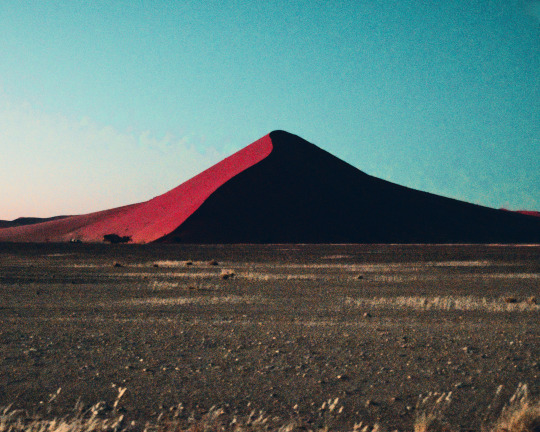
Dune at dawn - Sossusvlei, 2022
#original photographers#photographers on tumblr#travel#namibia#africa#nature#desert#landscapes#nature photography#dune#landscape photography
133 notes
·
View notes
Text
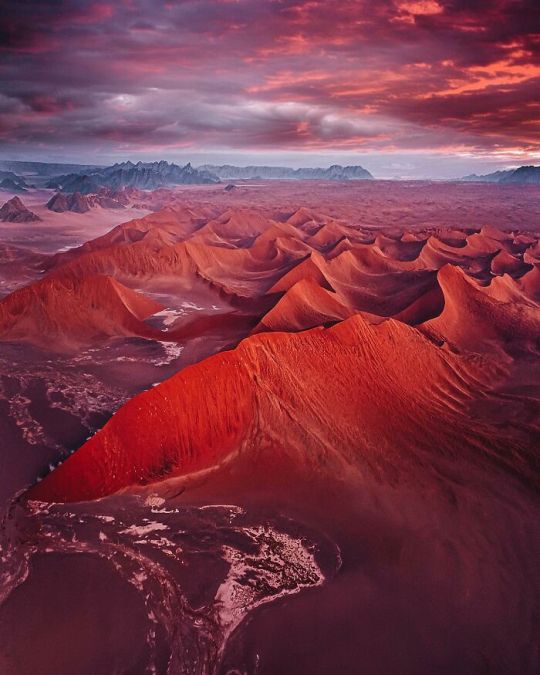
Magic Namib Desert, Namibia
By Kristina Makeeva
47 notes
·
View notes
Text

Instagram: @earth
270 notes
·
View notes
Text
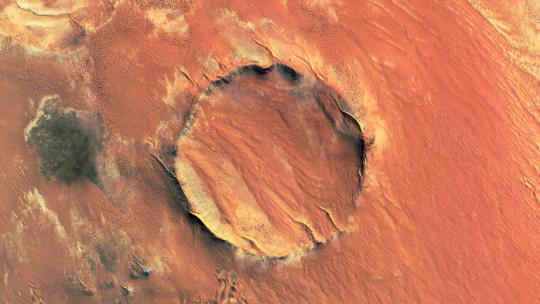
Roter Kamm crater - Namibia 🌍 4K link
#4k#wallpaper#google earth#satellite view#aerial photography#crater#namibia#roter kamm#desert#desertic#sand#dunes#orange#abstract#texture#landscape#atlas#earth art#earth from above#earth from space#dji#worldview
117 notes
·
View notes
Text


" The Ancient " // © getaway jonas
#Deadvlei#Sossusvlei#Namibia#nature#landscape#Dead Tree#Desert#Sand#Dune#Lake Bed#Dry Land#photography#aesthetics#wanderlust#explore#follow#discover
118 notes
·
View notes
